Existed: 1968 – present | Length 346.8 km | |
 | ||
From: | ||
The Tōmei Expressway (東名高速道路, Tōmei Kōsoku Dōro) is a national expressway on the island of Honshū in Japan. It is operated by Central Nippon Expressway Company. It is a part of Asian Highway Network
Contents
Map of Tomei Expressway, Japan
Naming
The word Tōmei is an acronym consisting of two kanji characters. The first character refers to Tokyo (東京) and the second refers to Nagoya (名古屋), which are the two major urban areas linked by the expressway.
Officially the expressway is designated as the First Tōkai Expressway. A Second Tōkai Expressway (operating as the New Tōmei Expressway) is under construction parallel to the existing route which will alleviate congestion problems in the near term.
The expressway is also a part of Route AH1 of the Asian Highway Network.
Overview
The Tōmei Expressway is an important roadway linking Tokyo and Nagoya. It is the most heavily travelled roadway operated by Central Nippon Expressway Company, with some sections used by more than 100,000 vehicles a day.
The first sections were opened to traffic in 1968 and the entire route was completed in 1969.
From the origin in western Tokyo the expressway follows a westerly route through Kanagawa Prefecture, paralleling National Route 246 and passing to the north of Yokohama. The route continues west into Shizuoka Prefecture, passing to the south of Mount Fuji and along the coastline of Suruga Bay, paralleling National Route 1 and the historic Tōkaidō highway before reaching the city of Shizuoka. The expressway continues west, passing Lake Hamana in western Shizuoka Prefecture, and crosses into Aichi Prefecture. The expressway then heads northwest, passing to the east of the city of Nagoya and meeting the terminus of the Chūō Expressway before terminating at an interchange in the city of Komaki to the north of Nagoya. Although the Tōmei Expressway ends at this point, the roadway continues as the Meishin Expressway towards Kyoto, Osaka, and Kobe.
